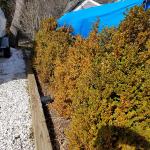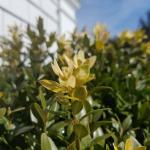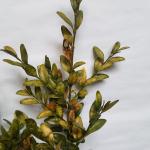A monthly e-newsletter from UMass Extension for landscapers, arborists, and other Green Industry professionals.
To read individual sections of the message, click on the section headings below to expand the content:
Hot Topics
2018 Massachusetts Landscape and Nursery Industry Survey
What are the needs and impacts of our landscaping and nursery businesses?
Please take our survey!
The goal of this survey is to gather information on the issues most important to the landscape and nursery industries in Massachusetts. This information will be used by researchers and Extension Educators at the University of Massachusetts to:
- Develop industry-focused research
- Create needed programming to support the industry
- Provide an overview of the state of the industry
This survey will not only help to focus research efforts, but will also provide insight on how national and state regulations and public perceptions of issues such as the impact of landscapes and plant production on pollinators are impacting the industry in Massachusetts.
The survey should take 10-15 minutes to complete.
If you have any questions or concerns, please contact Mandy Bayer at at abayer10@umass.edu.
New England Greenhouse Webinar Series
Check out the lastest webinar from the New England Greenhouse webinar series!
Ticks are active at this time!
Remember to take precautions when working outdoors and to conduct daily tick checks. The UMass Amherst Laboratory of Medical Zoology tests ticks for Lyme Disease and other tick-borne pathogens. Visit the Tick Report website for more information.
Questions & Answers
Q: What kind of damage can occur to boxwood during the winter?
A: Questions about boxwood tend to increase each spring, when pruning and cleanup jobs begin. The questions typically have to do with damage as a result of winter conditions.
Boxwood can suffer from several different types of damage during the winter. The most common type of damage is winter burn. This type of damage expresses itself as bronze, orange or burnt orange foliage (Fig. 1). Winter burn is often the result of desiccation related to winter wind and intense sunlight. Winter injury is another type of damage, winter injury damages or kills plant tissues like leaves and woody stems. The leaves of plants with winter injury are often yellow/white or straw colored (Fig. 2). When woody stems are damaged, the bark will peel or slip off the stem. Winter injury can be the result of extreme low temperatures or from drastic fluctuations in temperature. The third type of damage is the physical damage caused by snow or ice accumulation and the resulting breakage of branches and twigs.
The environmental conditions that contribute to winter injury and winter burn are something we may increasingly need to deal with as a result of climate change. This past year we saw extremely mild conditions well into November in southeastern Massachusetts. Conditions such as these can disrupt winter acclimation or result in deacclimation for species that don’t have long cooling requirements - similar to injury we see when we have long winter thaws. The plants become more vulnerable and, if followed by freezing temperatures or extreme cold temperatures, widespread damage is likely. Though we can not necessarily control the weather on a landscape scale, there are things we can do to reduce such damage to boxwood.
One of the most important aspects of a boxwood planting is proper placement in the landscape (Right Plant, Right Place). Boxwoods are intolerant of winter winds and require being planted in an area that provides winter protection. Sunlight also plays an important role in winter burn and potentially in winter injury. Boxwood are typically planted in full sun to part shade; however, care must be taken to consider winter sun. The angle of the sun in winter is much lower than in the summer and plants with southern or southwestern exposures are more likely to experience bright winter sun, which increases the chance of winter burn and winter injury.
Cultural conditions can also exacerbate winter injury and winter burn. Boxwoods have very shallow root systems and are susceptible to drought, heat, and cold. Mulch boxwood with 1-2 inches of mulch to protect the root zone and conserve water. Taper the mulch into the base of the plant so that it is not piled up around the base of the boxwood. When dry or drought conditions persist in the fall, make sure you provide adequate soil moisture before heading into winter. Pruning or shearing practices can also encourage winter injury. Avoid shearing boxwood in the late summer or fall, since shearing often encourages new growth. This new growth is often susceptible to winter injury because the new shoots do not have sufficient time to properly acclimate for winter.
Insect or disease damage can look like winter injury or winter burn and often times the two conditions co-exist. Insect damage from boxwood leafminer, Monarthropalpus flavus, can cause symptoms similar to winter injury or winter burn under severe infestations. The damage caused by the larvae also predispose the leaves to winter injury (Fig. 3). Volutella blight or canker, Pseudonectria rouselliana, can also be mistaken for winter injury. Volutella canker often results in straw colored leaves that remain on the plant, much like the symptoms of cold temperature injury to woody stems. Take the time to inspect symptoms closely to diagnose all the potential issues.
Depending on the severity of winter burn, the foliage sometimes will green up in spring as new growth starts. In more severe cases, the foliage will not green up but maybe sheared off if the interior foliage still has green color. In the worst cases of winter burn, plant replacement is likely necessary. Tissues that have winter injury can be removed by pruning or shearing. It is important to remove damaged plant tissues from boxwoods as they may otherwise become sources of disease for healthy parts of the plant.
Russ Norton, Agriculture & Horticulture Extension Educator, Cape Cod Cooperative Extension
Trouble Maker of the Month
Tree and Shrub Insect Pest Scouting
Spring is here! Welcome to the 2018 pest monitoring season! It may seem a bit premature to think that way, with snow still on the ground in some Massachusetts communities. However, with plans for new spring plantings and maintaining established landscapes, it is reasonable to think ahead about the arthropod pests we may encounter.
In a recent survey distributed to the readers of UMass Extension’s Landscape Message, 231 landscape practitioners in the Commonwealth responded to a question asking them to select which group of tree and shrub insect pests they encounter most during the course of their work. The categories they were given to choose from included bark/wood borers, defoliators, gall formers, leaf miners, piercing-sucking pests, root feeders, and shoot attackers. The top two categories selected nearly tied with piercing-sucking insect pests in first place and defoliating insect pests a close second.
With these results in mind, let us review some different clues that may indicate the presence of piercing-sucking pests and defoliators to monitor for during the 2018 season. Often times, magnification, such as with a hand lens, is necessary to see some of the signs these organisms leave behind.
Scouting for Piercing-Sucking Pests of Plants:
Certain types of insects feed on their host plants with piercing-sucking mouthparts. Typically, this involves the removal of plant fluids as these insects feed while attached to plant leaves, needles, twigs, branches, and sometimes trunks. Many of these insect species belong to the order Hemiptera, also known as the “true bugs”. This can include, but is not limited to, certain species of aphids, mealybugs, soft scales, armored scales, and lace bugs. Some non-insect arthropods, such as spider mites, may also cause problems as they feed on fluids from plant leaves and needles.
What are some clues we can use to monitor for the presence of these pest insects in our landscapes in the absence of the pests themselves? The following indicators may help:
Signs of Piercing-Sucking Pests:
- Eggs – While it may not always be possible to ID an insect based on the presence of an egg or discarded eggshell alone, their presence can be helpful in alerting us to the need to continue to scout. While some insects with chewing mouthparts may eat the discarded eggshell from which they emerge, thus leaving no clues to their presence, pests with piercing-sucking mouthparts are not able to do this. Therefore, the presence or past presence of certain pests, such as aphids and even spider mites may be detected via left behind eggshells.
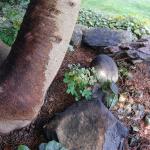
- Honeydew – This sugary secretion is a waste product produced by piercing-sucking insect pests such as aphids, soft scales, mealybugs, and certain hoppers. Leaves may look shiny from a distance if they are coated with this substance. Honeydew can coat leaves and branches, and both may eventually appear dark in color as sooty mold may grow on surfaces where honeydew is persistently available.
- Scale covers (tests) – Armored scale insects are covered and protected by hard, waxy shields sometimes referred to as tests. With armored scales, this covering is not attached to the body of the insect itself, and can be removed to reveal the soft-bodied insect below. Soft scale insects may also be in whole or in part covered by a softer “
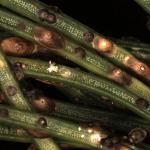 test” that is physically attached to their body. Attempts to remove a soft scale cover will result in removing the entire organism from the location they are fixed to. In either case, these scale coverings can be left behind even after these insects have died, but they may still be useful for identification. (However, not always. Some closely related scale insects must be observed beneath a microscope for ID to be successful.)
test” that is physically attached to their body. Attempts to remove a soft scale cover will result in removing the entire organism from the location they are fixed to. In either case, these scale coverings can be left behind even after these insects have died, but they may still be useful for identification. (However, not always. Some closely related scale insects must be observed beneath a microscope for ID to be successful.)
- Shed/Cast skins (exuviae) – As insects grow and develop, they shed or molt their exoskeleton multiple times during the course of their life cycle. The cast off exoskeleton (exuviae) is left behind by piercing-sucking insect pests and can be a useful sign of their presence.
- Tar spots – Sticky, black, sometimes shiny spots of excrement may be found on leaf surfaces where certain piercing-sucking
 insect pests are feeding. These “tar spots” are a quick and easy way to detect the presence of certain lace bugs found feeding on the underside of plant foliage such as that of rhododendrons and azaleas.
insect pests are feeding. These “tar spots” are a quick and easy way to detect the presence of certain lace bugs found feeding on the underside of plant foliage such as that of rhododendrons and azaleas. - Waxy/woolly material – These materials can be created by certain piercing-sucking insects as they secrete them over their bodies for protection. (Sometimes over eggs depending upon the species.) Waxy or woolly material may appear white or light in color and can be seen stuck to leaves, twigs, branches, or trunks. These materials can indicate the presence of certain woolly aphi
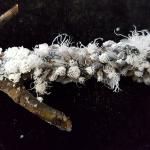 ds, mealybugs, and some scale insects. Silk, mentioned below as a common sign of defoliating insects, may also be a clue indicating high populations of spider mites.
ds, mealybugs, and some scale insects. Silk, mentioned below as a common sign of defoliating insects, may also be a clue indicating high populations of spider mites.
Injuries to the host plant due to piercing-sucking pest insects may appear in various ways, including but not limited to: bronzing/yellowing of needles or leaves, gall formation on various plant tissues (ex. leaves, twigs, etc.), leaf distortion (ex. wrinkling, cupping, curling, etc.), scarring, and stippling.
Scouting for Defoliating Pests of Plants:
Certain types of insects feed on the leaves or needles of their host plants. This can lead to either partial or complete defoliation of the host. Two orders of insects to which belong many common defoliators found in Massachusetts landscapes are the Lepidoptera (butterflies and moths) and the Hymenoptera (ants, bees, wasps, horntails, and sawflies). Certain species of defoliating caterpillars belonging to either of those orders may become problematic if present in high enough numbers. Certain moth caterpillars, inchworms, webworms, and tent caterpillars can be found on a wide variety of hosts. Sawfly caterpillars may be found feeding on the leaves of certain deciduous plants, while other species can be seen feeding on the needles of conifers. A third order of insects also provides us with many examples of leaf feeding species: the Coleoptera (beetles). In fact, a family of beetles known as the Chrysomelidae are commonly referred to as the leaf beetles due to their dietary preferences.
What are some clues we can use to monitor for the presence of these pest insects in our landscapes? The following indicators may help:
Signs of Defoliating Pests:
- Eggs – While it may not always be possible to ID an insect based on the presence of an egg, mass of eggs, or discarded eggshells alone, their presence can be helpful in alerting us to the need to continue to scout. Some insects with chewing mouthparts may eat the discarded eggshell
 from which they emerge thus leaving no clues to their presence. However, certain defoliating insect pests overwinter in the egg stage and if the eggs are distinctive enough, the insect may be identified this way. (For example, gypsy moth, eastern tent caterpillar, forest tent caterpillar, etc.)
from which they emerge thus leaving no clues to their presence. However, certain defoliating insect pests overwinter in the egg stage and if the eggs are distinctive enough, the insect may be identified this way. (For example, gypsy moth, eastern tent caterpillar, forest tent caterpillar, etc.) - Frass – This is the excrement produced by insects that feed on solid foods, so it is typically a term used to describe solid excrement (while the liquid, sugary waste produced by piercing-sucking insect pests is called honeydew). For some species of insects, the frass they leave behind can be distinctive and can help identify them or their presence, especially if this clue is found in association with other helpful diagnostic signs.
- Shed/Cast skins (exuviae) – As insects grow and develop, they shed or molt their exoskeleton multiple times during the course of their life cycle. The cast off exoskeleton (exuviae) may be left behind by defoliators; however, in some cases insects with chewing mouthparts may eat the shed skin, thus leaving behind no evidence of their presence.
- Silk – Certain defoliating insects produce silk or webbing at varying points in their life cycle. This can be a characteristic sign of some speci
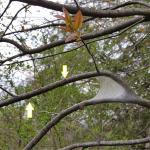 es of leafrollers, tent caterpillars, and webworms among others. It is worthwhile to note that some species of spiders use silk for various purposes. It is good to differentiate their activity, as many spiders are beneficial to our landscapes.
es of leafrollers, tent caterpillars, and webworms among others. It is worthwhile to note that some species of spiders use silk for various purposes. It is good to differentiate their activity, as many spiders are beneficial to our landscapes.
Injuries to the host plant due to defoliating pest insects may appear in various ways, including, but not limited to: defoliation (of course, but this can be in part or in full; ex. some insects eat the entire leaf except leaf veins, others are messy feeders on multiple leaves, eating less tissue per leaf, etc.), leaf rolling or folding (to create shelter around them as they feed), notching of leaf margins (in part or in full as the insect feeds from the leaf margin inward depending upon the species involved), and skeletonizing of leaf tissue.
This may not be an all-inclusive list for the types of clues that can be used to monitor for these two categories of insect pests. It is also important to remember that if these signs and clues are found on a tree or shrub of value that needs to be maintained, additional steps need to be taken prior to considering management. Identifying the host plant is often the first step to take to help identify the insect in question. Once an accurate insect identification is made, this may help when planning management options. Is this an insect that is known to be particularly damaging to its hosts? Is this plant susceptible or has pest resistance been observed? Are there cultural or mechanical management options available for this pest and, if so, is this the correct time of year to conduct them? What natural enemies are known for the pest of concern? Are these natural enemies typically able to keep the pest population below damaging levels?
If the pest is not known to be particularly deleterious to the host plant involved, additional monitoring may be necessary through the season. Additional management options may not be necessary unless the plant has a history of damage due to the pest in question or if damaging populations of the pest are observed or expected in 2018.
Need help identifying an insect pest on a tree or shrub? Submit a sample to the UMass Plant Diagnostics Laboratory at https://ag.umass.edu/services/plant-diagnostics-laboratory/tree-shrub-di... .
Sources:
Cranshaw, Whitney, and David J. Shetlar. Garden Insects of North America:The Ultimate Guide to Backyard Bugs. Second Edition, Princeton University Press, 2018.
Tawny Simisky, Extension Entomologist, UMass Extension Landscape, Nursery, & Urban Forestry Program
Plant of the Month
Magnolia x soulangeana, Saucer Magnolia
Saucer magnolia is a small deciduous tree growing about 20-25 feet tall and 20-25 feet wide. Fragrant, large white to purplish flowers appear in April. Saucer magnolia is hardy in USDA zones 4-9, prefers moist, acidic, well-drained soils and grows best in full sun to part shade.
The tree is a hybrid resulting from the cross of Magnolia denudata x Magnolia liliiflora. The original cross was made in France in the early 1800s. M. denudata is a pyramidal 30-40 foot tree with white flowers and M. liliiflora is an 8-12 foot shrub with purplish rose colored flowers. The resulting hybrid combines the characteristics of both parents, giving M. x soulangeana a larger size but often a multi-stemmed habit like a shrub, with flowers that range from pure white to purple, often containing a mixture of both colors. The hybrid quickly became popular and is one of the most commonly planted deciduous magnolias.
The tree is typically upright in youth, then becoming wide over time. Older specimens often have a very pleasing spreading habit with large, drooping lower branches. The drooping lower branches, smooth gray bark, and large fuzzy terminal flower buds provide winter interest. The large, 5-9 inch flowers are what makes it so garden worthy. Leaves are 3-6 inches long and are a dark green that remains attractive all summer long.
The tree is tolerant of all soil textures and is adaptable, but prefers a moist, rich, high organic matter soil. Saucer magnolia is not suitable for harsh sites or urban plantings. In the landscape, it is best suited as a specimen small flowering tree. The tree does have a few liabilities, the primary one being frost damage to the flowers while in bloom, which happens occasionally but not as much as with star magnolia, Magnolia stellata. Saucer magnolia is also a host for several scale insects and leaf spots; however, neither seem to be common problems.
Well known hardy cultivars include:
‘Alexandrina’ – flowers purple outside, white inside
‘Amabilis’ – flowers large cream color, some pink at base
‘Brozzonii’ – white flowers with some purple at base, flowers later than others
‘Verbanica’ – purplish/rose flowers, flowers with ‘Brozzonii’
Russ Norton, Agriculture & Horticulture Extension Educator, Cape Cod Cooperative Extension
Upcoming Events
Creating an Edible Residential Landscape
Have your landscape and eat it too! One of the biggest landscape trends currently is the incorporation of edibles into the landscape. These multi-purpose landscapes unite aesthetics and function. Come join us learn about how to design and maintain beautiful, functional edible landscapes. Learn from the experts what fruits are best for edible landscapes and tips for their incorporation, showy vegetables for food and beauty, designing a food friendly and functional landscape, insect pests of ornamentals and their impact on edible plants, and permaculture basics for the home landscape and garden.
- When: Wednesday, April 11, 2018; 9:00am-3:15pm
- Where: The Publick House, Sturbridge, MA
- Registration
Landscape Pests and Problems Walkabout - Diseases and Weeds
Get some hands-on experience scouting and identifying landscape diseases, insects, weeds, and abiotic problems. Join Randy Prostak, Extension Weed Specialist and Nick Brazee, Extension Plant Pathologist, for a walk through the landscape as they discuss and demonstrate how to put IPM practices to work efficiently and examine some of the most common pest and cultural problems of woody ornamentals.
- When: Wednesday, May 16, 2018; 5:00pm-7:00pm
- Where: Stanley Park; Westfield, MA
- Registration
Other Upcoming Events:
- 4/19: State Regulations Pertaining to Invasive Plant Mangement (A2) - rescheduled from 3/13
- 5/16: Landscape Pests and Problems Walkabout - Diseases and Weeds
- 6/6: Landscape Pests and Problems Walkabout - Insects and Cultural Problems
For more information and registration for any of these events visit the UMass Extension Landscape, Nursery, and Urban Forestry Program Upcoming Events Page.
Additional Resources
For detailed reports on growing conditions and pest activity – Check out the Landscape Message
For commercial growers of greenhouse crops and flowers - Check out the New England Greenhouse Update website
For professional turf managers - Check out Turf Management Updates
For home gardeners and garden retailers - Check out home lawn and garden resources. UMass Extension also has a Twitter feed that provides timely, daily gardening tips, sunrise and sunset times to home gardeners, see https://twitter.com/UMassGardenClip
Diagnostic Services
A UMass Laboratory Diagnoses Landscape and Turf Problems - The UMass Extension Plant Diagnostic Lab is available to serve commercial landscape contractors, turf managers, arborists, nurseries and other green industry professionals. It provides woody plant and turf disease analysis, woody plant and turf insect identification, turfgrass identification, weed identification, and offers a report of pest management strategies that are research based, economically sound and environmentally appropriate for the situation. Accurate diagnosis for a turf or landscape problem can often eliminate or reduce the need for pesticide use. For sampling procedures, detailed submission instructions and a list of fees, see Plant Diagnostics Laboratory
Soil and Plant Nutrient Testing - The University of Massachusetts Soil and Plant Nutrient Testing Laboratory is located on the campus of The University of Massachusetts at Amherst. Testing services are available to all. The function of the Soil and Plant Nutrient Testing Laboratory is to provide test results and recommendations that lead to the wise and economical use of soils and soil amendments. For complete information, visit the UMass Soil and Plant Nutrient Testing Laboratory web site. Alternatively, call the lab at (413) 545-2311.
